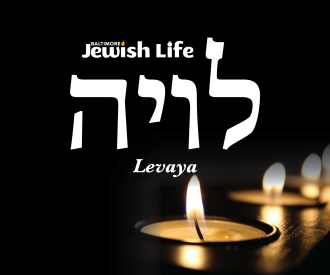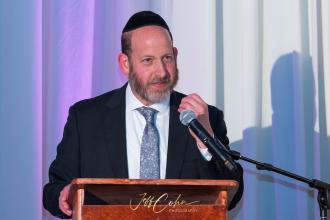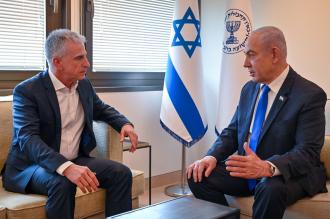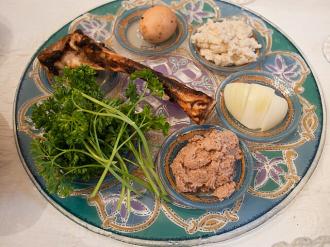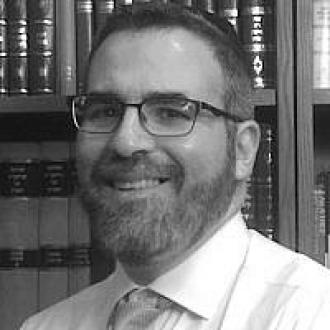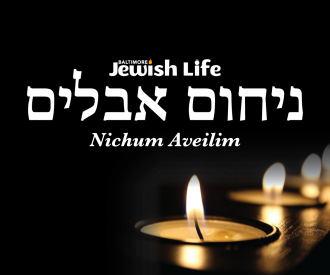Let’s gain an understanding about the custom of putting out greenery for Shavuos in a way that impacts our kabalas hatorah. Much of the material I drew from was started from a friend of mine, Rabbi Yehuda Spits at Ohr Sameiach. There’s a great article by Rav Gedalia Oberlander in Koveitz Ohel Yisrael which covers many ideas.
This essay is divided into two parts. The first is a lumdus shiur. The second build on that and explains ten reasons for greenery on Shavuos.
Part I: Lumdus – Chukas Hagoyim
Machlokes About One or Two Types
In Parshas Acharei Mos, we read: b’chukoseihem lo seileichu. Rambam, Tur and Shulchan Aruch say that this means that certain types of dress, haircuts and even building styles are not allowed. Tosfos in Avodah Zarah 11a is the game changer here. He says that there are two types of customs that we’re not allowed to follow. That is: idolatrous ones, which are obvious. All of the Rishonim agree with that. Those that are nonsensical. Meaning, there are certain things that even though they make no sense, the fact is the goyim do it, therefore we’re not allowed to copy it.
Most of the Rishonim don’t agree with the nonsensical one, and they think that that’s not something that we have to not do. For example, goyim do a lot of nonsensical things, so it doesn’t mean that we can’t do whatever we want to do, and just because they do something nonsensical and we have reason to do it doesn’t mean that we should stop doing it. That is really where the crux of this comment that we have about the Gra stopping the use of greenery in shuls, and that it being a problem of chukos hagoyim comes in. We’re going to get to that in more detail.
Vilna Goan’s Opinion
Rama (Yoreh Deah 168) explicitly says that he follows the Ran and the Maharik who say that it’s only if it’s idolatrous that you’re not allowed to do it. Gra comes along and says that since chukos hagoyim dictates that they put greenery in their prayer places, therefore we should not do it. There’s a debate what the Gra means and what that applies to. Whether it would apply to grass, trees or flowers or some of them or all of them.
Maharsham, Mishna Brurah and Aruch Hashulchan – Three Opinions
Maharsham says that Chukos hagoyim only applies if you’re copying exactly what they do, but since trees are places outside and inside their churches or places of worship, and we only do it inside the shul, so he says there’s no problem at all and he’s not worries about the Gra.
Now, one should follow their own minhag, and there’s a big debate as to whether the Gra might imply that he’s only referring to trees. Mishna Brurah says that explicitly that he was only opposed to putting the trees in the shul because chukos hagoyim. However, Aruch Hashulchan said that Gra meant everything- any type of plant adornment and not just trees is prohibited.
Yekies, Chassidish Communities and Eretz Yisrael
A lot of the Yekies as well as some Chassidish communities do have a minhag of putting everything in their shul, including trees. Other ones only put flowers and grass, but they follow the Mishna Brurah, and, out of respect for the Gra, they don’t put trees. Other gedolim, including the Chazon Ish, Stipler, Rav Shlomo Zalman, Rav Elyashiv, Rav Yisrael Yaakov Fisher zt”l, and, yibadul l’chaim, Rav Chaim Kanievsky, all say that the Vilna Gaon was only against trees and not grass. They follow the Mishna Brurah, and that certainly is a valid opinion.
Rav Elyashiv: In Eretz Yisrael
One of the most compelling arguments from Rav Elyashiv zt”l states simply: In Eretz Yisrael the non-Jews are predominantly Muslim and they do not use any trees or grass in their places of worship by policy, and so, therefore, we certainly don’t have to be machmir in Eretz Yisrael because, even if you agree with the Gra, it’s no longer chukos hagoyim here.
Rav Moshe and Rav Henkin - None
Rav Moshe Feinstein, interestingly told over that he recalled that back in Russia when they used to put trees up in some of the shuls, a lot of the talmidim of Volozhin Yeshiva, started by Rav Chaim Volozhin, talmid of the Gra, would rip down the trees and pull it away, and then other people would put them back. Rav Moshe understood that the Gra actually prohibited everything. Rav Henkin followed the Aruch HaShulchan who was his rebbe, whom he had s’micha from, and he held that nothing was allowed, and, in fact, in the famous luach that Ezras Torah puts out based on Rav Henkin, they don’t even mention anything about trees.
Rav Ovadia and other Sefardi poskim
Rav Ovadia Yosef and a lot of the other Sefardi posikim did support the idea of putting trees up or grass, plants and flowers as well. So, there’s certainly what to rely on both ways.
These are the opinions about greenery. May we have an inspiring and meaningful Shavuos.
Part II: Ten Reasons For Greenery
Rama: “Zeicher l’simchas Matan Torah”
We will now present ten reasons one can learn about Shavuos based on the greenery usage. Rama tells us to do it is in Hilchos Shavuos (Orach Chaim 494:3) He writes, “V’nohagin l’shtoch asavim b’Shavuos b’beis haknesses v’habatim Zeicher l’simchas matan Torah.” We have a custom to put greenery out on Shavuos, in the Beis Haknesses and, in the houses. This is in order to commemorate the happiness of matan Torah.
Lesson 1) Cattle and Sheep Prohibited
Levush says that the pasuk tells us that the cattle and sheep were not allowed to graze in the area of Sinai. That implies that there was grass there, and so, as a zeicher for matan Torah we put the grass out.
Holiness is Hashem’s Presence
So, what’s the lesson behind that? I believe that an interpretation would be that the animals were only prohibited from being there as long as the Divine Presence was there. Before and after the revelation, animals could graze there.
The Torah is showing us that the holiness is because of Hashem. Hashem is what gives us the holiness of the Torah as a nation because his presence is there, and that’s the most important focus that we want to have, and, I believe that’s an important, one might say, rationalistic, an important lesson behind. The kedusha comes because we invite Hashem in. That’s what it’s all about.
Lesson 2) A Fragrance Filled the World
Maharil says that we use fragrant grasses and flowers because the pasuk in SHir Hashirim says, “lachyav k’arugas habosem.” The gemara in Shabbos 88 talks about this phenomenal fragrance that filled up the world when Hashem gave the Torah. So, according to that, we should use fragrant things, which many plants do have good smells.
Torah Evokes our Feelings
I believe that the lesson here is twofold. First, Torah is a melody for our senses. Matan Torah had kolos and b’rakim. Torah is meant to enter deep inside us and there it evokes a lot of our feelings and emotions. Second, Torah brings a pleasant smell to the world and it uplifts the world in a spiritual way and we should know that.
Lesson 3) Bnei Yisrael is a Rose
Bnei Yissasschar says that k’Shoshana bein hakochim, Klal Yisrael is compared to a rose in between thorns and when we said, “na’aseh v’nishma”, that we would take the Torah, we want it, and we’ll follow it; we’ll do it, we save the world from being destroyed. To symbolize the z’man matan Torah, as the Medrash explains that just like the thorn threatens to destroy the rose, but ultimately does not, the rose will blossom, so too, when Klal Yisrael said, “Na’aseh v’nishma,” they saved the world from being destroyed. This lesson is very obvious, we’re remembering the na’aseh v’nishma part, and this would also hint to the fact that roses should be the preferred greenery that’s used.
Lesson 4) Haman’s Words
Targum Sheini in Esther is actually a source for this, and it’s even more interesting because the source is Haman. “Mei’oivi t’chakmeini!” Haman told Achashveirosh that the Jews do really strange things. They gather and spread apples and flowers on the roofs of their shuls on Shavuos. This would date this custom back much further than is probably even assumed. The lesson is that Klal Yisrael does things because of their excitement for kabbalas HaTorah. Even our enemy understood we were doing something special and wished to uproot that excitement from us.
Lesson 5) Shavuos Judgment
Magein Avraham says, very simply, the Gemara in Rosh Hashana says that peiros ha’ilan, the fruit trees are being judged at this time of the year, Rosh Hashana 16a, and, therefore, since they’re being judged, he says very clearly, that we want to put them in the houses and in the shuls so that we could see them and daven, so it’s trying to teach us to daven.
Shlah: Judged for Years’ Ruchniyus
There’s another remez which is “Adam eitz hasadeh”, that man is a tree, and like the Shlah writes that we’re being judged for our ruchniyus on Shavuos, so this is a time when we really want to daven that Hashem should allow our peiros hailan, our own Torah study to become fruitful.
Lesson 6) “Az Yiraninu”
Minchas Elazar of Munkatch says that “Az yiraninu atzei ha’yaar” the Zohar says that this refers specifically to the matan Torah, and like I said before there is some overlap between these, but it is a separate pasuk.
The Torah Uses Entire Body
Matan Torah was an emotional, physical, spiritual experience because Torah involves the entire body, and so this idea that the forest rejoiced before Hashem is referring to matan Torah is also an important thing because it’s telling us that everything we do we have to involve our entire body in our service of Hashem and the Torah is supposed to impact us. It’s “l’chol b’saro marpeh”, that it heals us, but that’s only because the Torah has to involve our entire body. We have to sweat for it. We have to give. We have to do. It has to have an impact on us, and that impact is the kollos and berakim of Har Sinai and the fragrant smells like we spoke about and all the emotions and all the reactivity.
Lesson 7) Reuven Found the Dudaim
The Midrash Talpiyos says a very interesting thing. In Parshas Vayeitzei it says Reuven went out and found dudaim “bimei k’tzir chittim.” There’s a p’shat that Alshich says this refers to Erev Shavuos. The dudaim were a fragrant flower, and fertility drug. Leah conceived Yissachar that night, on Shavuos. Yissachar is the greatest talmid chacham of the shevatim. That’s z’man matan Toraseinu.
Lesson 8) Moshe Rabbeinu
S’fas Emes from Chiddushei HaRim says Moshe Rabbeinu was born on the seventh of Adar, and was hidden at home for three months. When Yocheved couldn’t hide him any longer she hid him inside the reeds, a type of grass by the river bank. The pasuk explains that “v’lo yuchol od l’hatzpino”. Rabbeinu Bechaya says she couldn’t hide Moshe anymore because it was Shavuos, and he was shining so brightly. Thus, the reeds hint to the excitement and spiritual joy of Moshe about about kabbalas HaTorah.
Lesson 9) The Meaning of Eisev - Grass
Midrash Rabbah explains there is a connection between Shavuos and bikkurim. Bnei Yissaschar expounds on that and explains that eisev, which means grass, ayin-shin-beis, is actually roshei teivos for Atzeres, Shavuos and Bikkurim (names of Shavuos). So, once again, there’s a hint here.
Hakaras HaTov
What’s the lesson there? We need to be makir tov for everything that we have. Torah goes to people that are makir tov. Chazal tell us that Moshe couldn’t bring the first two makos, dam and tzfardeya because he couldn’t hit the Nile because it saved him. He couldn’t hit the earth because it helped him cover up the Egyptian man that he killed to defend the Jew, and so there’s a hakaras hatov.
The nation is started and the geulah is started based on gratitude. A person that is grateful to Hashem. Chovos Halevavos explains: The more a person recognizes what Hashem does for him the more he’ll serve Hashem even more.
Lesson 10) Every Blade of Grass
This is my own idea. Chazal tell us: Ein licha, there’s no blade of grass that doesn’t have a malach on top of it that hits it and tells it to grow (Midrash Rabbah). This famous Midrash is explaining Hashgachas Hashem - that Hashem watches over everything. Baal Shem Tov taught us that even a leaf doesn’t fall from a tree without Hashem knowing and wanting it to fall. This is one hint to grass. Torah teaches us to recognize Hashem’s Divide Guidance and Presence.
What We Grow From
There’s something even deeper there. Why is the blade of grass being hit, and why can’t the malach just tell it to grow. “Chochmasi sh’lamaditi b’af he umda li” (Midrash, Koheles Rabbah, made famous by Rambam). The wisdom that I learned through the wrath of those that were teaching me, that’s what remained with me. Part of Shavuos and kabbalas HaTorah is recognizing that we are dedicated to serve Hashem despite all hardship.
Why do we lain Rus? Chazal tell us one p’shat that it’s a scroll of chesed, so it’s chesed, there’s kindness there which is what the Torah is all about. Nourishing us. So many of the mefarshim explain that. There’s another p’shat which the Yalkut Shimoni says which is that it’s to teach us the mesiras nefesh of Rus as she was a geir and she was moser nefesh. She gave up everything. She’ll never be able to get married. Who’s going to want to marry her? “Amoni v’lo moavi.” There wasn’t a drasha accepted to allow her in yet. She understood that by converting she would probably be alone the rest of her life and never have children. But she gave it all up and converted, putting truth first and foremost.
She was told by Naomi, her mother-in-law, “Haod li bannim b’mei’ie?” You’re never going to get married.” Nevertheless, Rus said: I don’t care, I will convert anyway. Rus was moser nefesh for Torah. I’ll live in abject poverty and have to collect tzeddakka, but at least I will be a Jew! She became the mother of royalty. Oveid, Yishai Dovid, Shlomo. She lived to see Shlomo live on the throne.
It’s the mesiras nefesh that it’s all about, and that’s why the eisev is hit, the grass is hit because that’s what makes it grow, and that’s what the Rebono Shel Olam is teaching us: Shivticha u’mishantecha heima yinachamuni. The Rebono Shel Olam sometimes hits us. Life has nisyonos, but if we stay strong to the Rebono Shel Olam, it develops us into the best people that we could be, and when we stay strong to our beliefs and to the Torah, and we stay dedicated, the Torah takes care of us despite the challenges and everything that goes on in our life. Rav Shach said, “Lulei Sorascha shashu’I uz avaditi b’anyi”. He had so many challenges in his own personal life that he said: If not for the Torah he would have gone crazy and lost his mind. The Torah is what keeps us strong.
Final Idea
These 10 lessons revolve around different ideas of Shavuos, whether about grass or roses or fragrant trees. As we go through Shavuos, the main thing is that we should be able to live these lessons, be able to live the beauty of Torah, to be able to make Torah a part of our life and our focus, and to be able to take these lessons with us to recognize that Torah takes effort and the Rebono Shel Olam sometimes hits us, but that’s what makes us grow. It turns us into the greatest people, and when you’re mekabeil that, then we should be zocheh to what the Avos d’Rebbe Nosson says that which Rav Chaim brings down in Nefesh haChaim: When someone is mekabeil the yoke of Torah, Hashem removes from him all the other yokes, all the other burdens of tzaros, challenges. Hashem should bless us with only health, happiness, and success, and a year filled with Torah and growth, yiras Shamayim, and only good things.
Parshas Bamidbar
Gratitude and Facing Challenges
1) Remembering Hashem’s Kindness
Ramban starts off with a little introduction to each of the chumashim, and here he says an interesting thing. Bamidbar is mostly mitzvos sha’ah, temporary mitzvos that only applied at the time when the Jews were in the midbar, so why is it relevant to us? It reminds us of the nissim that happened and that we always have to tell over for all generations that a lot of these mitzvos came in order to remind the Jews of all the great things that happened. True, this sefer doesn’t have that many mitzvos that apply l’doros. Its purpose is to teach us a lesson that the Jews were in the midbar and they learned about serving Hashem, about getting close to Hashem and, most importantly, giving hakaras hatov to Hashem.
2) Rules of Counting Bnei Yisrael
“Tifkidu osam.” (Bamidbar 1:3) You have to count the Jewish people. Ramban tells us the famous p’shat in this pasuk that one is not supposed to count the Jewish people unnecessarily. That’s why it says “Tifkidu osam”, you should redeem them because you’re actually not supposed to count them directly, but rather you should use shekalim, so that you’re not counting them directly.
David’s Mistake
Ramban asks: What was the sin that Dovid made when it says he made a mistake and counted the Jewish people. How could Dovid not know this pasuk in the Torah that says that you’re not supposed to count them? Yoav, his general who was in charge of the process, why didn’t he change it to shekalim? Ramban explains that counting is not what David did wrong. What Dovid did wrong, whether with shekalim or without, was that it was not necessary to count the Jews then at all. They weren’t going out to war, and they weren’t dividing anything. Rather, he was just rejoicing over the fact that he was the king over a large nation. This should have not have been done.
Now, this is not to say that it was done because of his ego. David’s purpose, in his forty year reign as king of the Jews, from age thirty until seventy, when he died, was to bring out kavod Shamayim. This was that large goal in everything he did, building the Beis Hamikdash, etc. But, the idea was that at this time there was no real justification, and, therefore he was punished. Radak says the exact same thing: that he actually took kesef or some type of shekel, but the point was that it was unnecessary to count them, and that was the sin.
3) Significance of Yosef Listed with Efraim vs. Menashe
Ramban (Bamidbar 1:32) points out that sometimes it talks about Yosef in the context of Efraim, and sometimes it talks about him in the context of Menashe. For example, in this parsha where it’s talking about the degalim, it says, “Libnei Yosef, Libnei Efraim”, so Efraim is connected to Yosef. Why is that? Ramban says that Yaakov blessed Efraim that he would be the bechor, and so even though Menashe was the birth order bechor, Efraim had the status of bechor, and therefore in the given the pasuk here it specifically calls Efraim after Yosef to show that they were both the firstborns. Yosef was the first born of Rochel, and Efraim had the halachic status.
Yosef Listed with Menash
However, says Ramban, there’s another thing, and that is that when the meraglim spied the land, there it says Efraim first, but it only says Yosef’s name by Menashe. It says “L’mateh Yosef, L’mateh Menashe”. Why? Because Yosef brought dibbah, a negative report, about his brothers to Yaakov. He was the moitzei dibba, and so it’s hinting to the fact that the shevet of Menashe was one of the failed meraglim that came back and spoke lashon harah, just like Yosef was motzei dibba on his brothers. From Efraim, we know that Yehoshua was sent, and he did not sin, therefore, there’s no yichus to Yosef in that case.
4) Counting Lesson
Ramban (Bamidbar 1:45) says: I don’t understand why Moshe and Aharon were commanded to count the Jews here. Answers Ramban: It’s a lesson. It’s trying to teach us that: Look, you finally have gotten out of Egypt, you’ve gotten a Torah, you’re in the midbar. We’ve built the mishkan. Look at how far we’ve come. We started with seventy nefashos that came down to Mitzrayim with Yaakov, and now you guys are so, so large. So, it’s stressing, once again, like the Ramban said as a hakdamah, all that Hashem has done for us. A person should always take a moment to thank Hashem and recognize how far Hashem has taken him.
5) Each Degel Represents a Different Strength
We learn about the degalim (Bamidbar 2:2). The Jewish people wanted to have a formation. Of course, the psychological point of the formation is that it tells us that each person has their own spot of where they belong. Ramban explains a fascinating thing: The four directions of the camps are four different ideas.
Yehuda was the leader of the first degel, and he was the melech; He was like the king of the Jewish people.Yissachar was the ba’al HaTorah. He’s the one who carries the nation with his Torah wisdom. Reuven is the ba’al teshuva. He’s the one that was bilbul yetzuei aviv, and he teaches us that a person can always repent and change his ways. Gad is the ba’al gevura, the one that has strength. Now, where does he get this from? Because Gad’s name hints to Gedud, the legions of the army, and so there’s strength.
It’s important to have all four of these traits. A person should have leadership skills. A person should have Torah skills. A person should always be able to repent. A person should always have strength, ready to fight for Hashem.
6) Levy is So Small
Ramban (3:14) asks: Why is it that Shevet Levi is so small? They were the avadim and chassiddim of Hashem, beruchei Hashem, the blessed people; yet they are the smallest when you look at their census numbers?
Ramban, based on Chazal, explains that they weren’t in the shibud of Mitzrayim, in the avodas perach. Yosef had set aside the Levites throughout the entire Egypt, for the Egyptians as well in order to help plan for the Shevet Levi to still continue to learn Torah. So, they had a tremendous mission to carry Klal Yisrael. We see that Amram was the leader. He came from Levi. We see that Moshe and Aharon were the leaders of the Jewish people, and Moshe, like Rashi tells us in Chumash, walked around freely because he was from shevet levi. He was clergy. But, nevertheless, they weren’t in as much pain as the rest of the Jewish people. Therefore, Shevet Levi did not get the blessing of peru u’revu as much as the rest of the Jewish people. That’s why they were so small even now when the Torah counts them in Bamidbar much later.
Productivity
We see that, no one asks for nisyonos, but some of the most productive people, and some of the most productive moments in a person’s life is in their most challenging moments as well, in their hardest, backbreaking, challenging times, that’s when people grow the most. Ultimately, Levi had more freedom than the rest of the Jewish people, therefore, they did not get the blessing to be as fruitful and to multiply as much as the rest of the nation.
When a person is going through a challenging time, of course, “lo al yidei nissayon”, we always ask Hashem not to test us. We don’t’ want tests. We want to be able to serve Hashem. But let’s also recognize that sometimes, the most fruitful things in our life come in the most difficult of all situations. Hashem should give us strength to serve Him and to do what’s right at all times, despite any challenges we’re going through.
-
Rabbi Yosef Tropper is a rav and psychotherapist. Learn more and subscribe at ParshaThemes.com

